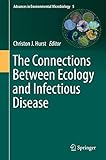The connections between ecology and infectious disease / Christon J. Hurs, editor
Hurst, Christon J [editor].
Tipo de material: Libro
impreso(a)
y electrónico
Series Editor: Cham, Switzerland, German: Springer International Publishing, 2018Descripción: xvi, 317 páginas : fotografías, ilustraciones, mapas, retratos ; 24 centímetros.ISBN: 3319923714; 9783319923710.Tema(s): Ecología microbiana
Libro
impreso(a)
y electrónico
Series Editor: Cham, Switzerland, German: Springer International Publishing, 2018Descripción: xvi, 317 páginas : fotografías, ilustraciones, mapas, retratos ; 24 centímetros.ISBN: 3319923714; 9783319923710.Tema(s): Ecología microbiana| Tipo de ítem | Biblioteca actual | Colección | Signatura | Estado | Fecha de vencimiento | Código de barras |
|---|---|---|---|---|---|---|
| Libros |
Biblioteca Campeche
Texto en la configuración de la biblioteca Campeche |
Acervo General | 579.15 C6 | Disponible | ECO040007083 | |
| Libros | Biblioteca Electrónica Recursos en línea (RE) | Acervo General | Recurso digital | ECO400598154251 |
Incluye bibliografía
Part I Introduction to Disease Ecology.. 1 Interkingdom Community Interactions in Disease Ecology.. 2 Biodiversity and Disease Transmission.. Part II The Ecology of Infectious Diseases Affecting Humans.. 3 Understanding and Estimating the Risk of Waterborne Infectious Disease Associated with Drinking Water.. 4 The Ecology of Bacterial Agents of Foodborne Illness.. 5 Impact of Mycobacterial Biofilms on Public Health.. Part III The Ecology of Infectious Diseases Affecting Livestock and Wildlife.. 6 Opportunistic Bacteria Associated with Mammalian Livestock Disease.. 7 Infectious Disease in Wild Animal Populations: Examining Transmission and Control with Mathematical Models.. 8 The Ecology of Pathogen Spillover and Disease Emergence at the Human-Wildlife-Environment Interface.. 9 Integrating Landscape Hierarchies in the Discovery and Modeling of Ecological Drivers of Zoonotically Transmitted Disease from Wildlife
Disponible para usuarios de ECOSUR con su clave de acceso
This book summarizes current advances in our understanding of how infectious disease represents an ecological interaction between a pathogenic microorganism and the host species in which that microbe causes illness. The contributing authors explain that pathogenic microorganisms often also have broader ecological connections, which can include a natural environmental presence; possible transmission by vehicles such as air, water, and food; and interactions with other host species, including vectors for which the microbe either may or may not be pathogenic. This field of science has been dubbed disease ecology, and the chapters that examine it have been grouped into three sections. The first section introduces both the role of biological community interactions and the impact of biodiversity on infectious disease. In turn, the second section considers those diseases directly affecting humans, with a focus on waterborne and foodborne illnesses, while also examining the critical aspect of microbial biofilms. Lastly, the third section presents the ecology of infectious diseases from the perspective of their impact on mammalian livestock and wildlife as well as on humans. Given its breadth of coverage, the volume offers a valuable resource for microbial ecologists and biomedical scientists alike. eng
Disponible en línea
Adobe Acrobat profesional 6.0 o superior
